ARTSHIP Ensemble 2006 Home Season in San Francisco, ODC Theater
The production of "Tarantella, Tarantula" is a unique and contemporary exploration of dance, music, and story telling. Under the direction of Slobodan Dan Paich, the production links modern needs to passionate, age-old practices of community, ritual, and healing.
The performance flows through nonlinear dance scenarios and music sequences, weaving a delicate and poignant story of immigration and assimilation, rich with ancient Mediterranean folklore, that is a confluence of cultural elements from Africa, Europe, and Asia that persist to this day, brought to California and across America by immigrants from southern Italy.
“This performance is not about a spider. It is about the age-old yearning to cure ‘The Dark Night of the Soul’. It is about our human need, in spite of all modern social dysfunctions, to help each other and to continue the search to recover closeness.”
Slobodan Dan Paich: Director, Dance Maker
ARTSHIP ACTORS, DANCERS, SINGERS & Staff
-
Catrina Kaupat: Giovannina Pascalis, recent
immigrant
also portraying Giovannina-s ancestors, spirit of Tarantella -
Tom Franco: Gaetano Carduni, young doctor
also portraying Giovannina-s ancestors, Spirit of Tarantella,
Gaetano-s father and brother -
Mardi Van Winkle: Signora Pascalis, Giovannina-s
mother
also portraying Giovannina-s ancestors, spirit of Tarantella -
AnaDiane Landelle: Signora Galo, Govannina's
oldest sister
also portraying Govannina-s ancestors, Spirit of Tarantella - Craig Coss: Anthropologist, Giovannina's descendant
- Eric Andler: Lighting Design
- Marie Perrey: Accordion
- John Kadyk: Clarinet, Steel Drum, and Bamboo Flute
- Jason Sheen: Stage Manager
- Matt Haber: Photography
- Sabine Grand: Announcement design
- Suellen Primost: Music Director, Cello
- Sabine Grand: Announcement design
Costumes and sets designed by Slobodan Dan Paich and co-created with Tom Franco (scenery/sculpture), Nathaniel Bolton (cloth sculp-ture), Robert du Domaine (cutouts), Kalim Quevedo (dress-making, tailoring), and Liz Diaz of North Beach Marin Canvas (large fabric constructions)
Story by S. D. Paich-written for this performance with Craig Coss
Images from the home season in San Francisco in fall of 2006 at the ODC Theater.
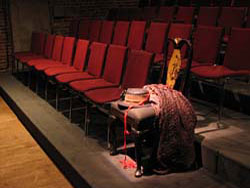
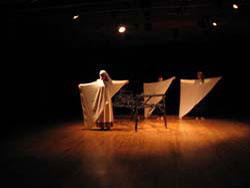
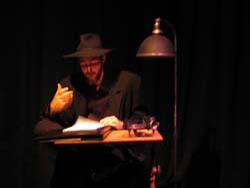

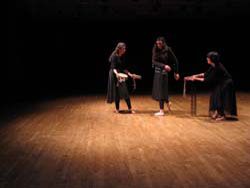
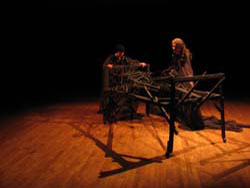
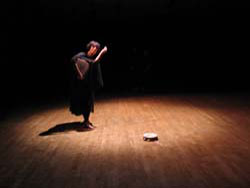
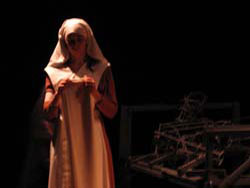
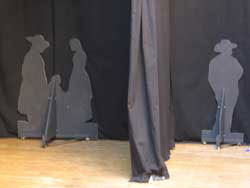

Pre-production Rehearsals 2005-2006
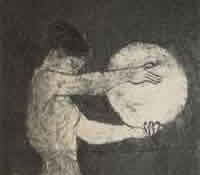

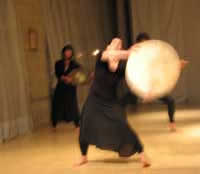
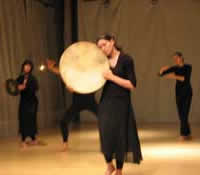
The performance will take place in the Lombardy poplar grove on the central lawn, most likely in collaboration with the San Francisco Neighborhood Parks Council, with which we are developing an ongoing collaboration called "Harvest of Secrets," a celebration of urban trees.
We are planning to present site-specific performances for the community during the Summer and early Fall of 2006, and to present the fully-staged theatrical production in Fall 2006 or Spring 2007.
Forms of Tarantella

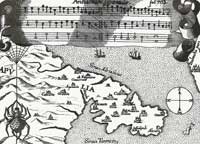
Three forms of Tarantella dances will be explored and represented in
our indoor theater performances: Tarantella de Core- a courting
dance for couples, Tarantella Scherma—a martial dueling dance for
men: and Tarantella Pizzica, the trance healing dance often danced
by women.
In our outdoor participatory performances we will teach and dance Tarantella de Core and tell the story of other two forms.
Ancient Dances related to Tarantella Pizzica
In Egypt these ancient dances go by the name of Zaar; in Algeria , they are called Jarjabou; in Tunisia Stimbali. In Morocco , they are performed by the tribe of the Gnavas, who claim Ethiopia as their country of origin. In Southern Italy they are called Tarantella Pizzica.
The trance dance is a ceremony that aims to harmonize the environment and its participants, it is a form of passing knowledge and healing, ether on a spiritual or psychological level, of problems that may result from suppressed wishes or needs or from some socially-induced repression.
The trance dance is not a form of entertainment, nor it is an exorcism. Its sole aim is to heal the body and help the person. All people who partake in such a ceremony have the duty to support the ‘sick’ person to the best of their abilities.
In the Ethiopian liturgy, the clergy at times dances and the drum is used.
Ancient Measures
As one of the starting points for the creation of new work and choreographic interpretations of ancient dances for modern times, Artship Dance/Theater is exploring very old measuring and surveying systems used all over the world. We are particularly interested in a possible flow of knowledge regarding these systems from Sub-Saharan Africa, North Africa and Ancient Egypt into the Mediterranean Basin and how exchanges between Africa, Asia and Europe may have influenced ancient measuring methods.
- Fathom: Distance from fingertip to fingertip of outstretched arms, approximately six feet.
- Bracca: Italian for arm, length of approximately a yard.
- Cubit: A distance from the elbow to the tip of fingers, 17.5 inches. The cubit was divided into seven palms or 28 fingers.
- Finger: 3/4 of an inch, subdivision in the Cubit system.
- Palm: 4 fingers, 3 inches, subdivision in the Cubit system
- Span: 3 palms, 9 inches. Cubit system.
- Foot: Some ancient Egyptian cubit rods indicated a foot measure the eighteenth finger, about 13,5 inches long. This is the origin of 12-inch foot.
- Pace: A step, Roman and biblical measure of approximately a yard.
The exploration of ancient measuring systems is our company's wayof intuiting and feeling timeless values in the bodies of the dancers and in the work we are creating. Elusive notions of measure, movement and sound in humanly-created places, dances and music from primordial time provide the inspirational grounding and greater context for the "Tarantella, Tarantula" performances in both its indoor and outdoor expressions.
Artship Dance/Theater Music
Emancipating musical communication through a melodic depth using pentatonic and octave scales, (similar to 1,2,3,5,8,... harmonic relationships in nature).
Sometimes going back to simple utterances of human voice in story telling as a guide to the musical exposition.
Cultivating music which is not mere accompaniment or incidental music, but an essential layer in counterpoint compositions with visual, dance and theater elements of Artship Dance/Theater productions.
Why We Like Stories?
Stories evoke panic and recovered closeness.
In the archaic recesses of our being we ward off unbearable levels of irrational anxiety through the need for and the mechanisms of personification.
To personify is to represent things or abstractions as having a personal nature, embodied in personal qualities.
When personification acquires duration, it begins to exist in time, and then a rudimentary story begins. This embryonic story, an individual inkling, finds great relief in joining the established flow of existing stories and well-known myths. That is why children love hearing old stories over and over again.
Although the word personification implies a human face or figure, the investment of natural and human-made objects and animals with certain qualities of soul or spirit, i.e., animism, are manifestations of the same process.
The phenomenon of Tarantism, the multi-faceted manifestation of illnesses and "moods" caused by the bites of Tarantula spider, and its cure through dance of Tarantella, are living examples of the process of personification. In the ritualized interplay of affliction and recovery, reintegration of the affected person into the community takes place through dance.
The positive side of this personifying, a story-seeking function, is to give us the sense of belonging, of community, of recovered closeness.
The negative side of the personifying process is investing others with our panic and creating chauvinism, racism and similar manifestations.
Just like the physical body continuously works to keep body fluids moving, temperature almost constant, the stomach acid at manageable levels, etc, so does the psychological self produce compensating, relieving images and non-verbal scenarios, or proto-stories to help us deal with life's complexities.
Continuous interplay of panic and recovered closeness is central in family or community life; it never goes away. Just as babies need continuous reassurance and feeding, so do adults, but in different ways.
Creating external "community commons" in public places through Culture Making, with a strong value and practice of diversity, will redefine "recovered closeness" for urban dwellers of the 21st century and potentially awaken new levels of inner connectedness.
The Role of Imaginative Function
The inner world of voluntary and involuntary imagining, the imaginative function, may be central to this re-awakening. Our human ability to nurture ourselves through sublimation and dreaming may offer a common link to the archaic layers of anxiety release through personification and enactment. The imaginative process is central to our recovered closeness. We do this nightly in dreams where, through dynamic images and an active process of personification, we self-heal and inadvertently deepen self-knowledge. This personifying function and its manifestation as rudimentary non-verbal sequences, with the potential for stories, is perhaps a starting point to reintroduce meaning, value and to revive ancient processes into contemporary life through enactment and art.
Performances and Performance: Sunday, Aug 19, 2007 - 3:00PM
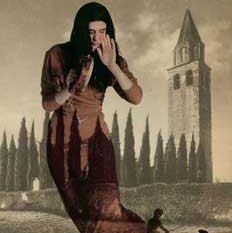
Following Artship Ensemble's invited performances at the Prague Fringe Festival, there is a chance to see this piece in the Bay Area at Commonweal in Bolinas, Marin County, California.
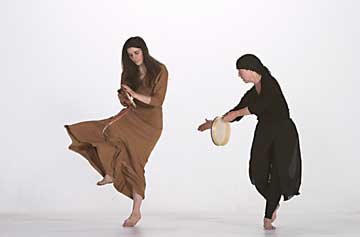
"Tarantella, Tarantula," a uniquely vital and contemporary exploration of dance, music, and story telling. Under the direction of Slobodan Dan Paich whose multi-disciplinary, idiosyncratic style has been described by critics in Europe as being at the nexus of dance, theater, cinema and "zen." Artship Dance/Theatre's production exudes a life force that expresses a continuity from modern needs to passionate, age-old practices.
The performance flows through nonlinear dance scenarios and music sequences, weaving a delicate and poignant story of immigration and assimilation, rich with ancient Mediterranean folklore &mdash a confluence, like watersheds, of cultural elements from Africa, Europe, and Asia that persist to this day, brought to California and across America by immigrants from southern Italy.
“This performance is not about a spider. It is about the age-old yearning to cure ‘The Dark Night of the Soul’,” state the program notes of the production. “Here we work with dance and music. It is about our need, in spite of all modern social dysfunctions, to help each other and to continue the search to recover closeness.”
For Artship's 2006 performance series, the company weaves verbal and non-verbal narratives in which the ensemble's actor/dancers perform more than one role, and elements of their actual ancestors and collective ancestral memories emerge in portrayals of the main characters. Giovannina Pascali, the protagonist female character, comes to America after World War I, the youngest child of the family that lost all its men in the War. The male lead character is Gaetano Carduni, a young American-born doctor whose family arrived in California a generation earlier, just after the Gold Rush of the 1890's. She is steeped in ancestral memory and "old-country" practices; he is enamored with science and modern advancements in medicine. Each character experiences a collision with the aspirations for assimilation in a new culture. Their lives entwine with the practice of the Tarantella dance.
The Tarantella has been employed for centuries by village elders, primarily women, in Italy and elsewhere. The dance's outward purpose is to ward off the negative effects of the poisonous bite of the tarantula spider, but its more general inward purpose is to offer tools to deal with oppression, unrequited love, and longings of the heart that do not have outlets in traditional societies. The performance is not a reconstruction of any particular regional type of Tarantella dance or music, but an immersion in the essence of Tarantella as a poetic framework for the production's narrative.
"Tarantella, Tarantula" portrays the issues that also face contemporary immigrants from Africa, East and South Asia, Latin America and Eastern Europe, as they try to create a new life here in California and other parts of America, living in two or more cultures at the same time. Their yearnings have as many shapes as there are human beings.
Artship Dance/Theater offers you the opportunity to enjoy a diverse, international and inter-generational group of actors, dancers, musicians and visual artists, who are working together, with a great amount of mutual support and respect. Our aim is to create unique, vital and contemporary explorations of cultural assimilation through deceptively simple movement, accompanied by live, tradition-based, original music and spoken word. In this process, our company may be re-interpreting the genre of physical story telling theater.
Artship programs have been recognized locally and internationally for reclaiming public spaces with performances and art exhibitions that create a meaningful resonance between audience and art in each setting. This work has spanned settings as diverse as boarded-up storefronts, historic landmarks, urban parks, an Art Deco Era steamship, the historic Truman House in Germany, medieval towers in Italy and Spain, and an Ottoman fortress in Serbia.
We invite you to arrive early to view the interpretative and visual art exhibit related to Artship's multi-year research into the origins and folklore of Tarantella dances.
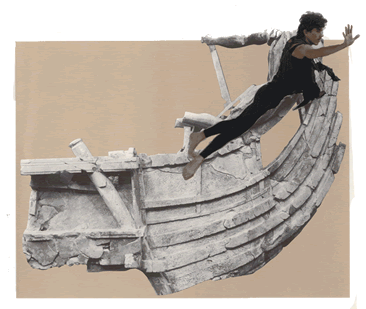
Performance flyer and poster
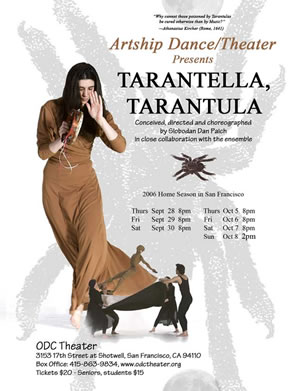
Invitation designed by Craig Coss
Performance program



BRIEF ARTIST BIOS
SLOBODAN DAN PAICH, dance maker and theater director, is cofounder and artistic director of Artship Dance/Theater (previously Augustino Dance Theater), where he has choreographed and directed with Augusto Ferriols since 1988. Before emigrating to England from his native Yugoslavia in 1967, Mr. Paich acted in radio, television and film from an early age in Belgrade where he started a number of experimental theater groups based on movement and dance, also coaching dancers to act and actors to dance. Since emigrating to the Bay Area in 1985, Mr. Paich has been involved in extending performing and visual arts into the community. He became Executive and Artistic Director of Artship Foundation when it was incorporated in 1992. He also served as director of arts and culture on the board of directors of the International Peace Foundation, Berlin & Vienna, where he commuted from the Bay Area from 1996 to 2002. At TanzFabrik (Dance Factory), in Berlin, he taught acting for dancers and performance for visual artists. He has received many community, state and national awards for art, performance, and community work.
CATRINA KAUPAT joined Artship Dance/Theater in 2002 as a core ensemble member and has performed in all of its productions since then. Catrina co-created and choreographed many theater elements including the narrative for the lead character in Artship Dance/Theater's 2004 San Francisco production of Same River Twice at the ODC Theater. Having graduated from the Laban-based Lola-Rogge Dance School in Hamburg, Germany, Catrina has performed and taught dance in both Europe and the U.S.
TOM FRANCO joined the company in 2004 as a core ensemble member. In addition to dance, he has grounding in yoga, Tai Chi, clowning, and singing. He graduated from the California College of Art and is skilled in both sculpture and metalwork. Tom is the principal collaborator in the creation of Artship Dance/Theater's idiosyncratic indoor-outdoor performance installations such as the shadow structure for audience participation and the "egg shapes" made of split bamboo.
MARDI VAN WINKLE, an Artship core ensemble member since 2001, began to study dance at the age of five in the Children's West Coast Program of the New York City Ballet under George Balanchine. She has been a lead dancer with the San Francisco Modern Dance Company, and she also choreographed and directed her own company, Open Arts, that presented environmental improv dance in San Francisco, performing in both traditional and unusual venues (such as parking lots, parks, streets, buses, and bridges). She has also taught dance to children.
ANADIANE LANDELLE, an Artship core ensemble member, was born in France in 1962. She studied with an American Indian teacher in British Columbia, where she was trained as a singer to participate in the sacred healing ceremonies of Si Si Weiss Medicine. In 2005, Ana Diane joined Artship Dance/Theater. She contributed to this production by helping to develop body-relevant and sensitive skill sets required to perform the Tarantella style movements and voice production.
CRAIG COSS graduated from Lewis & Clark College in Portland, Oregon, and has studied at the University of Washington and UC Davis. He has been involved in theater since he was nine years old, with a lifelong interest in the art of storytelling. Since then, he has worked to make myths and stories accessible to a wide range of people. For that reason, since 1994, he has told stories for schools, camps, parties, librarian conferences, and museums in Seattle and the North Bay Area. He is a Joseph Campbell Foundation Associate, and regularly contributes writings for the foundation's website. He has joined the Artship Dance/Theater company for this production.
ARTSHIP ENSEMBLE
SUELLEN PRIMOST, CELLO. Suellen began her cello studies at age ten and has spent a lifetime articulating musically what words alone cannot express. Throughout her career, she has explored diverse musical styles, ranging from early music to classical, ethnic to improvisatory. Suellen constantly pursues creative, authentic, dynamic, and innovative collaborations with dancers, actors, poets, and fellow musicians. She has performed with the Celestia Consort, Walkabout, and Duetto Lyrico; The Celebration, Alban, Mendelssohn and Mori Achen Trios; The Elysian Quartet and Espiritu Ensembles; and the Nashville, Taos and Roanoke Symphony Orchestras. Suellen co-founded and played in Sedona's First Jazz on the Rocks Festival. She composed the musical score and performed for the Herstories Project's theatre production of Bone Songs: Echoes of the Unknown Mother. Suellen was a guest performer with the Living Arts Playback Theater Ensemble of Berkeley and performs regularly on recording sessions with various Bay Area artists as well as with the Artship Dance/Theater, where she has served as its Music Director since 2002.
JOHN KADYK, CLARINET & STEEL DRUM. John has been fascinated by music of all kinds since childhood. First inspired by his mother's playing, he started piano at age six, violin at nine, clarinet at ten, and gradually added instruments until now there is little room for anything else in his apartment. In addition to Artship Dance/Theater, he currently performs with the Living Arts Playback Theatre Ensemble and various other musical ensembles. John studied music at Oberlin College and has made musical pilgrimages to Trinidad, Cuba, and Ireland.
MARIE PERREY, ACCORDION. Marie joined Artship Dance/theater in 2004. Born in France, where her study of flute began at age ten, Marie taught music to children in Paris for several years. She has sung alto in a Baroque chorus and played bass guitar for nine years in the rock band Open in Paris.
LIGHTING DESIGN
ERIC ANDLER, LIGHTING DESIGNER, is the Technical Director at ODC Theater since February where he designed lights for the Scuba and Migrations programs. Additionally in the Bay Area, he has worked with Dance Mission Theater, Magic Theater, the West Wave Dance Festival, and East Bay Arts High School. Eric received his degree in acting from Illinois State University, and has performed in Chicago and the fringe festival in Edinburgh, Scotland.
ARTSHIP DANCE/THEATER | ELEMENTS OF OUR WORK
Artship Dance/Theater always works with the germ of an idea as a point for gathering diverse artists and disciplines to create performances for specific sites or theater.
Dance. Movement is our primary response to embodying and expressing ideas. Whatever we do in the theater, we always start by exploring movement. Although we use words and narrative, expression through dance-not literature-is the primary motivation in our theater. Artship Dance/Theater is a small gesture, physical storytelling theater company that generates its expression through dance movement first, however small.
The company works with mature dancers who are creating, rediscovering, and relearning movement vocabulary appropriate to their bodies, and in that way they are continuing and expanding their poetic range. The company also works with emerging dancers whose expressions and explorations have not yet been set in any particular movement language. From its origins in East European experimental theater, the company encourages actors to dance and dancers to act.
Theater and Visual Arts. We often work in site-specific environments, like the stables of an historic house or the cargo holds of a ship, and we painstakingly tune them for the performance. But when we use a stage, we 'tune' the space rather than decorate it. It is a meaningfully enriched environment, appearing transformative or empty, but not neutral. Our artists carefully craft our costumes and props, and we often exhibit them for years after performances as pieces of art or sculpture.
Often, several of our principal performing artists are also accomplished practicing visual artists, in such media as sculpture, tectonic, painterly, and conceptual but non-verbal elements, all of which contribute to the general staging of our dance/theater work.
Cinema. We often use photographed sequences, but even when we do not, there are elements of performance staged more like film than theater, and sometimes they are intended as strong counterpoints to the stylization of dance and ritual.
Music. Music is the lifeblood and the oxygen of our performances. The company includes a small ensemble of accomplished and dedicated musicians who improvise and create new material continuously; they bring to life in music the ethno-musicological research the company is always engaged in.
Spoken Word. Once thematic focus is chosen, the contextual parameters set, and the structural and dramatic outcomes sketched, the narration and the story grow organically out of all the processes involved.
Imaginative Function. We see the inner world of voluntary and involuntary imaginative function as central to our dance/theater making. We are fascinated by the human ability to nurture ourselves through sublimation and dreaming, and our capacities of resilience, survival, and adaptability. We see the imaginative process as central to these functions and art as necessary food for it. We believe strongly that we speak to ourselves in dreams through dynamic images as a means of self-healing and self-knowledge.
Zen. Although we are not practitioners of Zen per se, company members may or may not practice different forms of meditation or prayer. Our visual metaphors and poetic paradoxes, as well as particular relationships to empty spaces, are tuned, idiosyncratic measured timing that has been associated with elements of abstraction, ambiguity, and complexity-perhaps similar to the Zen aesthetic-as a counterpoint to other elements of the performance.
SPECIAL THANKS
SUPPORT FOR THIS PRODUCTION
Tarantella, Tarantula is funded in part by a Donor-Advised Fund-Tides Foundation, Grants for the Arts/San Francisco Hotel Tax Fund, and by the generous contributions and in-kind support of individual donors.
ARTSHIP BOARD OF DIRECTORS
Dr. George Leitmann, Chair; Frank J. Giunta, President and Acting Treasurer; TheArthur Wright, Secretary; Nina Manzo, Dr. Paul Pangaro, Dr. Jasmina Vujic, and Katie Wolf.
INDIVIDUALS
Lottie Rose, Barbara and Tom Sargent, Dennis Letbetter, Robert du Domaine, Liz Diaz, Rob Bailis and Vera Ilijin.